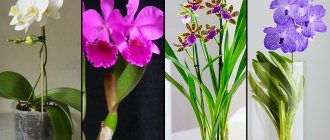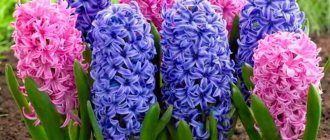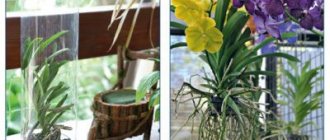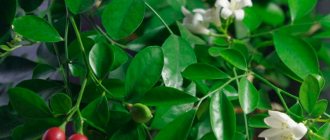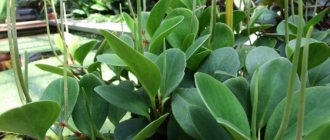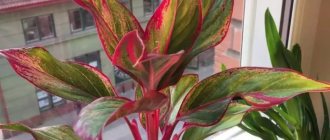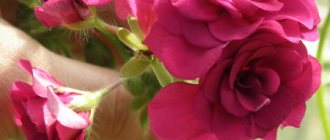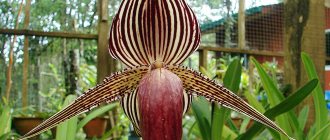The aroma of vanilla has been loved by many since childhood. Even after growing up, people often retain a particularly warm attitude towards him. Meanwhile, not everyone knows that the most delicious and fragrant spice is obtained from orchids. This amazing flower grows in equatorial countries. The cost of the spice is so high that they are trying to grow it in other regions. If you want to find out what else is special about the vanilla orchid, look at its photos and find out how to care for it, read our article and you’ll figure it all out.
Origin and history of the Vanilla orchid
An exotic flower is by definition an epiphyte. That is, it is able to take root on tree trunks (living or fallen) and stumps. Less common are orchids that live directly on the ground.
The name Vanilla (sometimes spelled incorrectly as “vanille”) is translated from Latin as “small pod.”
Now the plant is cultivated as an agricultural crop in countries with tropical climates. Half of the world's spice production comes from Madagascar.
In Europe, the plant was unknown for a long time. Only in the 16th century did they begin to import dry spice into the Old World. It was very expensive, and therefore botanists tried to adapt the flower to a more temperate climate.
Their success should be considered only partial. It was possible to grow orchids, but they did not produce precious pods. European botanists did not take into account an important detail. The crop needs pollination, and only one species of endemic bees, which lived exclusively in Mexico, did it.
Things got off the ground when a manual fertilization method was developed in the mid-19th century. The first scientific description comes from the pen of Henry Andrews, a British botanist. His work dates back to the beginning of the 19th century.
The Vanilla Orchid is being actively improved by breeders who have so far created more than 100 of its varieties. True, not all of them are suitable for growing at home.
Method of making spices
Vanillin is extracted from vanilla seeds, which ripen in pods. First, the seeds are treated with boiling water, then a long process begins, during which the seeds are alternately heated in the sun and steamed in plastic containers. This process takes about two weeks, after which the seeds darken and turn dark brown. Then, the seeds are dried and simply kept for several months so that the smell intensifies.
The following types of vanilla are cultivated today for the production of vanillin:
- Vanilla is fragrant. Grows in Mexico, Indonesia, the Caribbean and Madagascar. It is distinguished by large inflorescences. It has a rich, “warm” aroma.
- Antillean vanilla. It grows in Central America, at an altitude of 0.5 km above sea level. Most often used as an extract.
- Tahitian vanilla. The place of cultivation of this plant, which is the result of crossing the two species described above, is French Polynesia. This species is grown not only for the production of vanillin, but also for decorative purposes.
This is how natural vanillin is produced, but most of the spices sold in stores are artificially produced vanillin. It is made from various raw materials through synthesis.
Description of vanilla orchid, photo
In the wild, Vanilla is a very long vine. The length of individual specimens reaches 30 meters. Such a giant would not fit into any photograph.
The aerial roots, characteristic of the entire family of exotic flowers, are located along a flexible stem. They, among other things, provide reliable fastening of the plant to the tree.
At home, an orchid is usually kept in a flowerpot, and the shoots are supported by ladders, decorative arches, etc.
Vanilla leaves are fleshy, mostly colored emerald green. In some varieties they are variegated, that is, variegated. The latter are decorated with light green wide stripes.
The shape of the plates is oval, pointed, and quite dense. Peduncles are short racemose. They grow from the axils of almost all leaves. The older the orchid, the more shoots it produces and, accordingly, the more magnificent it looks.
Each peduncle in nature produces up to 10 medium-sized buds (diameter about 60 mm). In a house their number rarely reaches 5 pieces.
The vanilla orchid does not indulge in a wealth of shades - its flowers are always greenish-yellow. The lip is elongated, with a white edging. Elongated and petals.
Important: in order for the buds to appear, it is necessary to reproduce the conditions of the tropical forest at home as accurately as possible.
By and large, only two varieties are suitable for an apartment:
- Flat-leaved orchid (Latin - Vanilla planifolia);
- Lemon Splash.
The first one adapts perfectly to home conditions, but is distinguished by abundant flowering, lasting up to a month only in nature. The buds emit a strong, characteristic aroma. They bloom one by one.
The second variety has large elliptical leaves, fleshy and rich green. A distinctive feature is its very long aerial roots. Their healthy shade is gray, closer to white. Flowers the color of ripe lemon.
Peculiarities
The vanilla orchid is primarily unique for its size. If phalaenopsis, more common in our area, rarely reaches 0.6-0.8 m (with peduncle), then the culture in question stretches up to 15 m.
Thanks to its great flexibility, the vine fits freely in any room, even a very modest one. Over time, of course, she will cover it all and turn it into a wonderful corner of tropical nature.
Every year the plant adds at least 50 cm, and in ideal conditions - even 100 cm. Another difference between the orchid is that it stores water directly in the stem, while other relatives accumulate liquid in the roots or leaves.
Content
- 1. Growth 1.1. Climate in natural habitats
- 2.1. Size and type of plant
- 3.1. Temperature
About flowering
The first buds appear on young orchids no earlier than three years later. This rule is equally relevant for both wild and cultivated specimens.
In the latter case, you often have to wait much longer for flowers. They open mainly in mid-spring or early summer.
The chances of harvesting your own vanilla crop are very slim. The fact is that it is not enough to achieve flowering; it is also necessary to pollinate correctly (by hand).
Regardless of the phase of its life cycle, an orchid needs a lot of heat and water. You will also have to constantly maintain high humidity.
In summer there is enough light for the flower, but in other seasons it is impossible to do without a phytolamp. The normal length of the day is at least 12 hours.
When flowering is completed, the crop enters a resting phase. At this time, it does not need abundant watering and large portions of fertilizers.
You shouldn’t really hope for the appearance of buds - in our area they are formed extremely rarely. However, the decorative value of an orchid lies primarily in its leaves and long, intricately curving shoots.
For flowering to begin, you will need:
- raise the humidity to about 85-90%;
- provide strong diffused lighting (this is difficult due to the length of the vine).
It will not be possible to stimulate the release of arrows using daily temperature fluctuations.
There is another, rather risky way. To do this, the flower is placed directly under the sun's rays. The problem is that it does not give a 100% guarantee, but the leaves will certainly suffer.
Properties
Good quality vanilla pods are usually 10-20 centimeters long, soft, elastic, rounded, oily to the touch, dark brown or almost black. The best varieties are also covered with a coating of whitish crystals. When stored properly, the persistence of the vanilla aroma is amazing. There are known cases of preservation of all properties after 36 years from the date of production. Due to improper storage or preparation, the pods lose their elasticity, become brittle, crack, open and lose color, becoming light-colored. This vanilla has already lost half of its qualities. Poor quality varieties quickly fizzle out and are destroyed, especially in unfavorable conditions. Less valuable also include varieties of vanilla that have the aroma of heliotrope instead of vanillin. In them, the aroma carrier is piperonal (heliotropin).
Home care step by step
Despite the significant difference between the Vanilla orchid and other members of the family, its maintenance conditions are generally the same. Let's tell you about everything in more detail.
Where to put
The flower needs light and warmth. He can get all this by standing at a window oriented to the east or west. The northern direction is absolutely not suitable, and the southern direction remains the third acceptable alternative. However, here the orchid must certainly be protected from sunlight. A loose white curtain does the job well.
In summer, Vanilla can also be exhibited outside, but again in a shaded place.
Pot and soil
Choose a container for the plant that is wide, not cramped and not very deep. The material does not play a significant role. Both plastic and ceramic will do. The container should have holes in the bottom and on the walls - the roots need air.
Often the pots are hung or kept in flowerpots - this is how the climbing crop looks best.
Advice: be sure to install supports for the vine, since without them it often breaks under its own weight.
There are three criteria that the substrate must meet:
- high breathability;
- good moisture capacity;
- looseness.
Regular soil for the orchid discussed in this article will not work. It cannot be used in its pure form.
Add to its 2 parts:
- 3 – leaf soil;
- 1 – charcoal;
- 2 – perlite.
It is more advisable to use expanded clay as a drainage material.
Temperature
Regardless of the time of year, the Vanilla orchid requires warmth. The air in the room where it is kept should not cool to more than +20 °C. Moreover, it is desirable that the indicator be kept at +25 °C. In summer, the temperature will be +25 °C…+28 °C.
What the flower does not tolerate is sudden changes. The limit here is only 4 degrees. With more significant temperature fluctuations, he is highly likely to get sick.
Humidity
The plant reacts poorly to dry air - growth stops in such conditions. The optimal figure is 85%. Make sure it never drops too much. The general rule is that the hotter the room, the higher the humidity.
To regulate this parameter, it is necessary to use warm water sprays or showers.
Ventilate the room daily. Experienced flower growers often install a fan in the door of the room - it draws out stagnant air.
Lighting
Everything is simple here - the more, the better. Light should enter the room all day, and certainly diffused.
Avoid contact of foliage with the sun's rays, they burn. As a result, the plates quickly lose turgor, often wither and fall off.
If the flower is placed on a western window, then after lunch it should be shaded, regardless of whether it is summer or winter.
Watering
The Vanilla Orchid, the care of which we describe at home in this article, loves regular irrigation. Boiled or filtered water is suitable. Rain water is also allowed to be used, but provided that you collected it outside the city.
The temperature of the liquid cannot be lower than room temperature, but it is better if the indicator is +30 °C ... +32 °C.
Make sure that the soil in the pot is always left slightly moist. Give water strictly in the morning, as needed, just in the pot. Once a month, watering is done using the immersion method.
The order is as follows:
- Place the orchid in a tall container of suitable diameter.
- Carefully fill it with warm water to the ground level.
- Wait a quarter of an hour.
- Remove the flower and allow excess moisture to drain.
Important: Always remove any water that accumulates in the pot tray. It can cause root rot.
When the culture enters the dormant phase, all that remains is to ensure that the substrate never completely dries out. Add liquid in small portions, every other day.
Top dressing
During the active growing season, which falls in the spring-summer season, fertilizers are applied once a decade or twice a month. The intensity depends on the growth rate of the flower.
It is better to use ready-made complex formulations made specifically for orchids. Choose those where nitrogenous compounds predominate. With them, leaves and stems will be able to develop faster. Separate them more than the instructions recommend. In winter, the dosage is halved.
Apply fertilizers in the form of a solution, about half an hour after irrigation. Pour them over the edge of the pot.
Transfer
The orchid is moved to a new container and substrate every 2 or 3 years.
This procedure is required when:
- the roots no longer fit into the old container;
- the soil loses the necessary properties or turns sour;
- the flower gets sick.
The optimal time for transplantation is spring.
Choose a pot 2-4 cm larger than before. At the same time, it is advisable to carry out pruning.
The procedure is as follows:
- Sprinkle the substrate generously with warm water.
- Carefully remove the plant from the container.
- Wash the roots and inspect them, cut off any suspicious ones.
- Rub the wounds with charcoal powder.
- Treat the underground part with a fungicide and leave to dry.
- Place 2-3 cm of drainage material into the new pot.
- Set the orchid.
- Fill all voids with soil.
Application area
A spice with a wonderful aroma and a rich spectrum of beneficial effects has found its application in various areas of our lives - cosmetology, medicine, cooking. The beneficial qualities of vanilla are successfully used everywhere.
Cooking
Vanilla bean is a spice, without which many dishes would not have such a unique taste, and, most importantly, aroma.
Natural spice is far from cheap, so it is used more often in the menus of reputable restaurants and expensive cafes. In the confectionery industry, cheaper analogues of vanilla are preferred.
The famous Guryev porridge is a real delicacy today. But it turns out that it cannot be fully prepared without using aromatic seasoning.
Where do you add vanilla beans?
Natural spice is used mainly for flavoring high-quality confectionery products:
- exclusive chocolate;
- fillings for expensive sweets;
- nut and Christmas cookies;
- creams for gourmet cakes;
- premium alcohol products.
If the price of the issue does not matter, then there are plenty of options for how to use the pod:
- for flavoring ice cream;
- as an important flavor component of biscuits, puddings, soufflés;
- as an additive to dairy products - yoghurt, cream, curd spreads;
- in the production of drinks - liqueurs, Coca-Cola, cocktails.
The confectionery industry often uses vanillin as a more affordable additive to products:
- jelly, moussam;
- jams, preserves;
- compotes, fruit drinks;
- glazes, syrups.
Vanilla flavors not only sweets - if you mix the spice seeds with olive oil, the resulting substance will favorably highlight the taste of meat, poultry, seafood, and sauces.
Dosages
Have you always believed that a spice with a sweet aroma should have a corresponding taste? In the case of vanilla, everything is different - it is bitter. Therefore, it is so important to maintain the exact dosage in order to enrich the taste of the dish and not spoil it.
The correct proportions are:
- a quarter of a vanilla stick will be used for 1 kilogram of product;
- 1/20 of the pod is enough for 1 serving of the dish.
Vanilla sugar for dough or sprinkling a finished dish is made as follows: powdered sugar (0.5 kg) is ground with 1 spice pod.
In what dosage is vanilla essence used? 3 drops are enough for 6 servings of food.
How to properly use a vanilla bean?
To prepare desserts, including vanilla cream, you need to cut the spice pod, separate the seeds and boil in milk or cream.
Sliced pod
Vanilla extract is prepared by pouring alcohol into the pod cut into pieces (30 ml is enough). You need to insist for at least 3 weeks.
Vanilla seeds are most often used in cooking. The pod itself can be placed in a sugar bowl to give the sweet substance a special aroma.
Vanillin in sugar bowls
By placing the pods in a container and pouring sugar syrup, you can get vanilla syrup. It is infused for about 2 weeks and stored for up to six months.
Vanilla syrup
What to replace the pod with?
Since the vanilla bean spice is expensive, not everyone can afford to use it often.
Therefore, vanillin, an artificially synthesized product, is actively used in cooking. There are probably packets of this confectionery seasoning in every home.
What else can you substitute for vanilla bean:
- Vanilla extract - small spice pods infused in an alcohol solution.
- Essence - a more concentrated infusion of vanilla.
- Vanilla powder - ground pods of the plant.
- Vanilla sugar - natural (the pods are covered with sugar and, tightly closed, left for 7-10 days) and artificial (sugar is mixed with vanillin).
Cosmetology
The beauty industry has found application for the beneficial properties of vanilla in decorative cosmetics - the spice is included in creams and hair products. Perfumers also love the scent of vanilla.
Cosmetology develops products based on vanilla extract and essential oil.
Cosmetic preparations with vanilla have a beneficial effect on the skin:
- whitens and removes pigmentation;
- reduce irritation, calm;
- promote hydration and softening;
- tone, making the skin more elastic;
- counteract the harmful effects of the environment.
Vanilla creams belong to the line of expensive cosmetic products.
Spice as one of the components is included in hair cosmetics: shampoos, conditioners, balms, gels.
Cosmetologists recommend using vanilla oil as a valuable natural product as a hair mask. Its beneficial effect is to nourish and moisturize the skin and strands thanks to its active substances. Just a few drops of vanilla oil added to the hair mask will make your curls silky and your hair voluminous.
Vanilla oil is used to prepare:
- mixtures for relaxing baths - they also include honey, milk, cream, rose oil;
- anti-cellulite scrub based on ground coffee beans and almond oil.
Vanilla oil is used for massage - it helps to nourish the skin, eliminate inflammation, and relieve tension.
Medicine
The pharmaceutical industry uses vanilla in the production of herbal preparations.
Information: Herbal preparations are medicines that are obtained by extraction from plant materials. They come in the form of tinctures and extracts (alcoholic and aqueous).
Products containing vanilla are used in therapy:
- cramps, to stimulate muscle activity;
- stomach ulcers, colitis, digestive problems;
- anemia, vitamin deficiency;
- insomnia;
- pain during menstruation;
- climacteric disorders;
- nervous system disorders;
- sexual problems - to increase libido.
Pharmaceuticals use vanilla as a flavoring agent for medicines. Healing essential oil is produced from the plant. Its consistency is thick and viscous, its aroma is persistent and spicy.
In aromatherapy, vanilla oil is used to relieve stress and irritation, normalize sleep, and relax. The aroma of the spice helps to produce serotonin in the body - the hormone of joy and pleasure. Essential vanilla oil is effective in the treatment of ENT diseases.
Reproduction
The easiest way to obtain new Vanilla specimens is to use cuttings. The latter is taken as a fragment of a stem, at least 30 cm long, with living buds.
The algorithm is like this:
- Remove the leaves at the bottom.
- Stick the cutting into soil poured into a small pot.
- Water a little.
- Cover with a cut plastic bottle.
- Place it in the shade.
An improvised greenhouse must be ventilated daily. It is necessary that the temperature in it is constantly maintained at least +25 ° C. Water the soil little by little but often.
In about a month, the cuttings will take root. After this, remove the protection and place a new copy on the windowsill.
Advice: the sharply accelerated growth of the seedling will tell you that the procedure was successful.
Diseases and pests
The specific aroma of an orchid (even the leaves emit it, although much weaker) repels insects. Thus, they should not be feared. If parasites are found on nearby flowers, Vanilla should be sprayed with Fitoverm for preventive purposes.
Diseases pose more dangers. They arise mainly due to non-compliance with maintenance rules.
Systemic waterlogging of the substrate provokes rot (root, stem). In this case, trim the damaged areas with a sterile instrument, sprinkle the wounds with cinnamon, and transfer the orchid to new soil and a pot.
Among fungal infections, late blight and anthracnose are dangerous to the plant. They are signaled by dark spots that form on the leaves and stem. Destroy the infection with fungicides. There is no need to worry about other diseases common among orchids.
How to use vanilla beans in baking:
To prepare vanilla-flavored dough, it is not the pod itself that is used, but the seeds inside it. Therefore, you first need to extract the seeds from the vanilla pod as follows:
- Immediately before adding vanilla seeds to the dough, place the vanilla pod on a clean and dry board with the curved end of the vanilla pod pointing up.
- Hold the vanilla pod with one hand and take a small knife in the other hand.
- Carefully cut the vanilla pod lengthwise to the depth of the center, so that its edges can be moved apart, but not into 2 parts. Don't hurt your hands! If you want to add half a vanilla pod to a dish, then it must be cut lengthwise to half its length.
- Open the edges of the pod with your hands.
- Gently scrape the seeds from the vanilla bean into the batter, following the proportions indicated in the recipe. If you add more vanilla than required, the dish may become bitter.
Preventing problems
Yellowing leaves indicate a lack of water. The situation will be corrected by more intensive watering and spraying 2-3 times a day. If the flower is exposed to the sun, it will develop burns. Move the pot into the shade or protect it with a curtain.
Excess water causes root rot. To prevent this from happening, water the flower without fanaticism. As stated above, the main thing is that the substrate always remains moderately moist and no more.
Proper care and a comfortable microclimate will ensure the active development of the vanilla orchid. A healthy plant will quickly turn your living room into a cozy green corner. With a successful combination of circumstances, it will also begin to bloom.
POLLINATION
Just like others, the vanilla flower contains female and male reproductive organs. Under natural conditions, pollen is transferred from one flower to another by the melipona bee and thus pollination occurs. The flower is protected from self-pollination by a membrane called the rostellum.
0
Edmond Albius, who worked as a servant for one of the French colonialists, somehow figured out to lift this membrane with a sharp bamboo stick, and then carefully connect the pollen bag with the pistil with his thumb, thus artificially pollinating the flower. It worked and for the first time vanilla bore fruit outside of Mexico. It was a huge breakthrough. Edmond's method of hand pollination has now made it possible to grow vanilla all over the world.
0
Soon, Reunion Island and nearby Madagascar will become the main suppliers of vanilla in the world, which will provide this region with unprecedented prosperity. Just 50 years later, Madagascar was producing several times more vanilla than Mexico, providing approximately 80% of the world's vanilla supply. Mexico's share gradually decreased and today is less than 10%. Unfortunately, the discovery of Edmond Albius, which enriched his island and gave vanilla to the whole world, did not bring him anything: Edmond received his freedom, but died in poverty in 1880.
0
But his method of pollination, after almost 200 years, is still alive and is still used to this day in the cultivation of this spice. But why is vanilla still so expensive?
